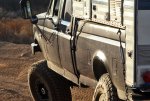View attachment 759525
This was posted recently on the “Overlandy Meme Thread“. Having seen a video of his in the past and thinking it was a well-built Tundra, I found these two videos about how this happened that are quite detailed and pretty interesting as to the cause and results of the event (along with being typical Youtuby clickbait epic journey stuff).
The first video (chapter four, part two) shows the actual incident that bent the frame starting shortly after the 17 minute mark. The second video (chapter five) recaps the issue, but then goes on to show him limping this screwed up Tundra up over Lippincott Pass (during the night and with a fast leaking, radiator!) into death Valley where he gets picked up.
The owner appears to have built this rig to be a combination overland vehicle, and a desert racer. Early in the chapter 4 video, he speaks about the suspension allowing him to bomb over the road, and mentioned he’s going 65 mph in one stretch. You’ll see the frame bending incident was him miss-gauging a dip in the road because he was going so fast. He also mentions that he can’t believe how well the truck handles the camper despite the camper’s 2200lb weight! I suspect this guy is/was more than double his trucks payload, not to mention it’s a crew cab and the camper sits farther back.
He sure made a lot of questionable decisions, and he does admit to everything that happened being fully his fault, but he doesn’t address the role speed and weight played in the problems he had. I pretty much think he’s an idiot, but I have some grudging admiration for how he got himself out of the fix he got into, and the toughness of the poor Tundra.

